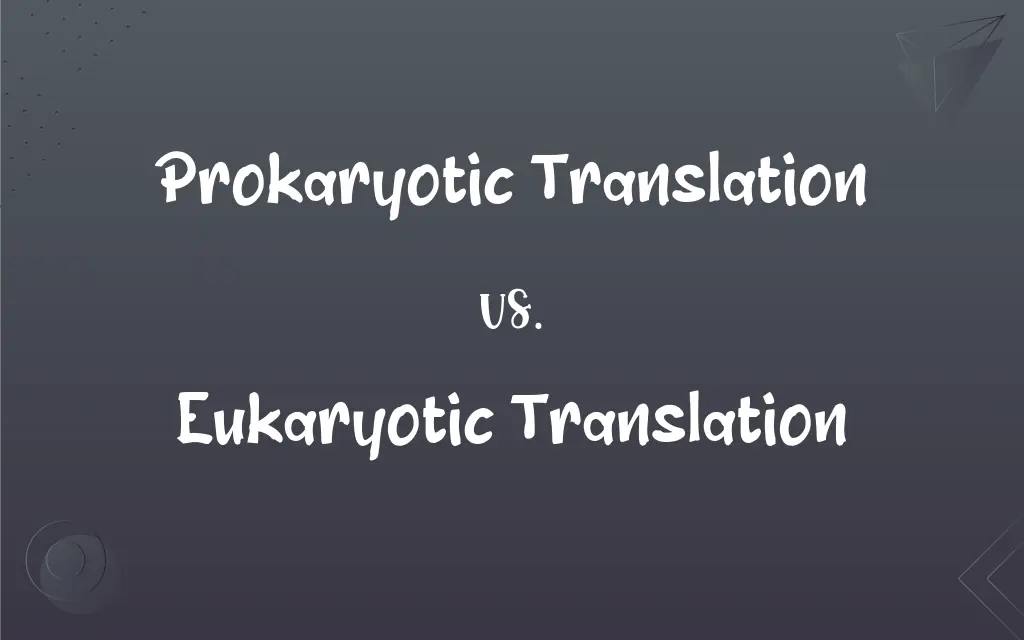Prokaryotic Translation vs. Eukaryotic Translation: What's the Difference?
Edited by Aimie Carlson || By Harlon Moss || Updated on October 18, 2023
Prokaryotic translation occurs in the cytoplasm of bacteria and archaea, simultaneous with transcription. Eukaryotic translation happens in the cytoplasm of eukaryotic cells, separated from transcription in time and space.

Key Differences
Prokaryotic translation and eukaryotic translation are fundamental processes by which cells synthesize proteins. However, they differ based on the cell type and the cellular structures involved. Prokaryotic translation refers to the process in prokaryotes, namely bacteria and archaea, while eukaryotic translation pertains to eukaryotic cells, which include plants, animals, fungi, and protists.
One prominent distinction between prokaryotic translation and eukaryotic translation is the site of occurrence. In prokaryotes, due to the absence of a defined nucleus, translation starts in the cytoplasm immediately after the start of transcription. This simultaneous occurrence is termed as 'coupled transcription-translation.' In contrast, eukaryotic cells have a well-defined nucleus, so transcription occurs inside the nucleus, while translation takes place in the cytoplasm.
Another key difference lies in the initiation process. In prokaryotic translation, the ribosome binds to a specific sequence on the mRNA called the Shine-Dalgarno sequence to start protein synthesis. Eukaryotic translation, on the other hand, initiates when the ribosome recognizes the 5' cap of the mRNA molecule.
Ribosomes, the molecular machines responsible for protein synthesis, also differ between prokaryotic and eukaryotic systems. Prokaryotic ribosomes are smaller, termed 70S, with subunits 30S and 50S. Eukaryotic ribosomes are larger, termed 80S, with subunits 40S and 60S.
Lastly, post-translational modifications are more intricate in eukaryotic translation. While both types of cells can modify proteins after synthesis, eukaryotic cells have a broader repertoire of modifications, facilitated by the endoplasmic reticulum and Golgi apparatus.
ADVERTISEMENT
Comparison Chart
Cell Type
Bacteria and Archaea
Plants, Animals, Fungi, and Protists
Site of Occurrence
Cytoplasm, simultaneous with transcription
Cytoplasm, separated from transcription
Initiation Site on mRNA
Shine-Dalgarno sequence
5' cap
Ribosome Type
70S (30S and 50S subunits)
80S (40S and 60S subunits)
Post-translational Mods
Limited
More extensive, involving endoplasmic reticulum and Golgi
ADVERTISEMENT
Prokaryotic Translation and Eukaryotic Translation Definitions
Prokaryotic Translation
The cellular procedure in prokaryotes that translates genetic code into functional proteins.
Prokaryotic translation plays a vital role in bacterial responses to environmental changes.
Eukaryotic Translation
Protein synthesis in eukaryotic cells occurring in the cytoplasm.
After mRNA exits the nucleus, eukaryotic translation begins in the cytoplasm.
Prokaryotic Translation
A mechanism in prokaryotes to interpret mRNA and produce corresponding proteins.
Chloramphenicol disrupts prokaryotic translation, leading to bacterial growth inhibition.
Eukaryotic Translation
The process where eukaryotic ribosomes decode mRNA sequences to produce a protein chain.
Eukaryotic translation involves larger ribosomes than those in prokaryotes.
Prokaryotic Translation
The process where mRNA sequences are decoded by ribosomes in prokaryotes to produce a polypeptide.
Antibiotics targeting prokaryotic translation can inhibit bacterial protein synthesis.
Eukaryotic Translation
The mechanism in eukaryotic cells that interprets mRNA to generate the corresponding proteins.
In humans, errors in eukaryotic translation can lead to various diseases.
Prokaryotic Translation
Protein synthesis in bacteria and archaea.
In Escherichia coli, prokaryotic translation is efficient and rapid, aiding in quick growth rates.
Eukaryotic Translation
The event in which eukaryotic cells use ribosomes to read mRNA and produce proteins.
Ribosome biogenesis is crucial for efficient eukaryotic translation.
Prokaryotic Translation
The event where prokaryotic ribosomes read mRNA sequences to form proteins.
Coupled transcription-translation in prokaryotes enables immediate protein synthesis after mRNA formation.
Eukaryotic Translation
The cellular procedure in eukaryotes translating the genetic code into functional proteins.
Disruptions in eukaryotic translation can affect cellular growth and differentiation.
FAQs
Why is the ribosome type different in prokaryotic and eukaryotic translation?
Evolutionary differences have led to distinct ribosomal structures in these cell types.
What is prokaryotic translation?
It's the protein synthesis process in bacteria and archaea.
How are post-translational modifications different between prokaryotic and eukaryotic translation?
Eukaryotes have more extensive modifications, facilitated by specific organelles like the ER and Golgi.
What cellular machinery performs prokaryotic translation?
Prokaryotic ribosomes, mainly of the 70S type.
Can eukaryotic translation be regulated at multiple levels?
Yes, it can be controlled at initiation, elongation, and even during post-translational modifications.
Are there inhibitors specific to eukaryotic translation?
Yes, some compounds can specifically target eukaryotic protein synthesis machinery.
Can prokaryotic translation produce complex proteins with multiple subunits?
Yes, but subsequent assembly is needed after individual protein synthesis.
How do prokaryotic cells handle misfolded proteins from prokaryotic translation?
They utilize protein chaperones and proteolytic systems to refold or degrade them.
Why is the Shine-Dalgarno sequence significant in prokaryotic translation?
It's the mRNA sequence where prokaryotic ribosomes bind to initiate protein synthesis.
Are there differences in the speed of prokaryotic and eukaryotic translation?
Yes, prokaryotic translation is generally faster due to its simultaneous occurrence with transcription.
Are there any diseases associated with errors in eukaryotic translation?
Yes, errors or disruptions can lead to various diseases, including cancers.
Can antibiotics target prokaryotic translation?
Yes, some antibiotics specifically inhibit bacterial protein synthesis.
What happens if prokaryotic translation is inhibited?
The cell cannot produce proteins, affecting growth and survival.
Which organelles assist in post-translational modifications during eukaryotic translation?
The endoplasmic reticulum and Golgi apparatus.
How do cells ensure accuracy in prokaryotic and eukaryotic translation?
Both utilize specific tRNA molecules and ribosomal checks to ensure correct amino acid incorporation.
How does eukaryotic translation differ from its prokaryotic counterpart?
Eukaryotic translation occurs in the cytoplasm, separated from transcription, and involves different initiation sites and ribosome types.
Is transcription and translation coupled in eukaryotic cells?
No, they are separated in time and space.
How are ribosomes synthesized for prokaryotic translation?
They're produced from ribosomal RNA and protein components within the prokaryotic cell.
Is eukaryotic translation more energy-intensive than prokaryotic translation?
Generally, due to more complex machinery and modifications, eukaryotic translation can be more energy-demanding.
Why does eukaryotic translation require a 5' cap recognition?
The 5' cap ensures correct mRNA positioning and stability during translation in eukaryotic cells.
About Author
Written by
Harlon MossHarlon is a seasoned quality moderator and accomplished content writer for Difference Wiki. An alumnus of the prestigious University of California, he earned his degree in Computer Science. Leveraging his academic background, Harlon brings a meticulous and informed perspective to his work, ensuring content accuracy and excellence.
Edited by
Aimie CarlsonAimie Carlson, holding a master's degree in English literature, is a fervent English language enthusiast. She lends her writing talents to Difference Wiki, a prominent website that specializes in comparisons, offering readers insightful analyses that both captivate and inform.































































